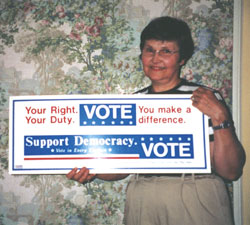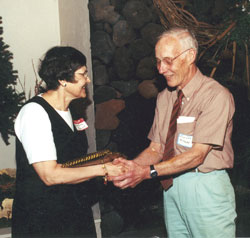
The League of Women Voters (LWV) is a nonpartisan political organization which encourages the informed and active participation of citizens in government. The League influences public policy through education and advocacy, because, as their website proclaims, “democracy is not a spectator sport!” Here in central Illinois, the local chapter, the League of Women Voters of Greater Peoria, serves Peoria, Tazewell and Woodford counties.
A League is Born
The League of Women Voters grew out of the National American Woman Suffrage Association (NAWSA) in 1919. The League was first a part of NAWSA and was made up of several organizations in the states in which women had already won the right to vote. (The Illinois legislature passed a bill allowing women the right to vote in 1913.)
In 1920, just one year later—and six months before the 19th amendment was ratified, extending suffrage to women nationwide— the League of Women Voters was formally organized in Chicago. Carrie Chapman Catt, then-president of NAWSA, described the purpose of the League:
The League of Women Voters is not to dissolve any present organization but to unite all existing
organizations of women who believe in its principles. It is not to lure women from partisanship but to
combine them in an effort for legislation which will protect coming movements, which we cannot even
foretell, from suffering the untoward conditions which have hindered for so long the coming of equal
suffrage.
These sentiments have remained at the heart of the League’s work in communities nationwide from 1920 to today.
The League in Peoria
In 1924, Julia Proctor White became the first president of the League of Women Voters of Greater Peoria. She strived to promote political responsibility through informed and active participation of citizens in government and acted on selected governmental issues in central Illinois, according to current President Mary Jane Crowell.
Laura McCluggage was one of the first members of the LWV of Greater Peoria. Crowell said she was a 21-year-old teacher and long-time member of NAWSA when the women suffrage amendment was passed, and was instrumental in starting the Greater Peoria chapter.
Another notable member of the LWV of Greater Peoria, Dorothy Sinclair, told about how the new Peoria police station came to be. When young men from Peoria went off to fight in the war, they found that their hometown was known throughout the country for its prostitution district and corrupt government. Because of this, when our soldiers came back from war, they were set on reforming Peoria, beginning with a new police station. The city, however, did not want to spend the money necessary to make these great changes.
After looking into the matter, the League of Women Voters got behind these men and fought the city with them. They organized an open house at the old police station, now the election commission office, offering cookies to citizens as they went to see the overcrowded station. A policeman took them on tours so they could see firsthand the terrible condition that the station was in. Eventually, their efforts paid off with the construction of a new police station.
League of Women Voters?
Even “from the very beginning…it was apparent that the legislative goals of the League were not exclusively focused on women’s issues and that citizen education aimed at all of the electorate was in order,” as stated in “History of the League.”
In 1974, men were admitted to membership, and a discussion began about whether to drop the “Women” from the League’s title. This issue was again brought up at two recent national conferences,and the decision was made to keep the name consistent. According to Crowell, “it was and is felt that there would be a problem of identity if ‘League of Women Voters’ is dropped.” She added that male members do not seem to have a problem with the name.
United They Stand
Chapters of the League of Women Voters are affiliated at all levels— national, state and local. “If the local league does not agree with an official position of the state or national leagues,” Crowell said, “they cannot have an official position. However, local leagues are very active in the formulation of the policies for both state and national leagues. It has always been a grassroots organization with policy positions beginning at the local league level.”
By the organization’s own rules, it cannot endorse any candidate running for any office. Likewise, the president and voter service chairs may not publicly endorse any candidate. The League is adamant about this, and the individuals who hold these offices are not allowed to show signs supporting any candidate on their lawns, actively work on a candidate’s campaign or financially contribute to specific candidates or parties.
Priority Issues
All discussions of issues within the League of Women Voters remain nonpartisan. They have a system for studying issues which allows them to take an informed stand on each one while remaining true to their nonpartisan identity.
According to Crowell, the Peoria chapter of the LWV recently studied the issue of immigration. They reviewed background information from last year, met to discuss any new information on the subject, answered questions, rated all of the information and notified LWVUS of their decisions. Crowell said this issue will come up at the national convention in June and anticipates that the League will take a stand on the issue at that time. After the national conference, the League’s lobbyists will take their final stand to Congress. She said that these lobbyists are in a very good position to influence our legislators in Washington, D.C. 
At this time, another key issue for local and state chapters of the League is redistricting the state legislature. The Peoria chapter is currently holding study groups on this issue and suggests that the state redistrict in a way which does not favor one party or another, as the Illinois districts currently do.
The local League is also focused on the election of judges. When a judge is up for appointment or re-election, the League compiles a biography and information on each candidate so citizens know who they are voting for. Crowell said that, currently, citizens do not know much about the judges who are being elected, or even why they are supposed to vote on the issue in the first place.
For this reason, voter education is one of the highest priorities of the League of Women Voters. They have started including high school students in voter education through presentations and mock elections. The League holds candidate forums with WEEK-TV and WCBU. There is also a possibility that they will work with the ACLU in April on a debate for the 18th Congressional District election.
In taking other steps, such as registering voters at Department of Motor Vehicles offices throughout the state, the League helps citizens participate in the election process. Crowell said, “We want them to be informed and educated, but not harassed when it comes time to cast their ballots.” These efforts, along with electronic voting machines and provisional ballots, are big steps in terms of voting reformation.
Another reformation the League feels strongly about is the abolition of the electoral college. Crowell said “the League of Women Voters, United States has a position which was established in 1970 and revised twice, most recently in 2004, which states: ‘Promote the election of the President and Vice President by direct popular vote and work to abolish the Electoral College.’” We all know the havoc that can arise with the current system, as the 2000 presidential election aptly demonstrated.
In Peoria
On a local level, some of the issues with which the League of Women Voters of Greater Peoria has dealt include the reduction of the size of the Peoria County Board and cumulative voting.
In the early 1980s, when the County Board was reduced from 36 to 18 members, the League had pushed for a board of just nine members. Crowell noted that, while the League didn’t get exactly what it wanted, it was a definite improvement, making the Board a more efficient and effective body.
The issue of cumulative voting has been around for years now, and Crowell said that no one really knows if it’s working or not. The process was introduced in 1991 as a compromise to settle a civil rights lawsuit brought by African-American voters against Peoria’s City Council, District 150 School Board and Park Board in 1987. In cumulative voting, voters are given five votes which can all be given to a single candidate or spread out among two or more candidates. This process was supposed to increase the number of minorities elected to the City Council.
Last summer, the Peoria Area Chamber of Commerce called a group of about 15 people together to look at the cumulative voting process. The group has met three or four times so far. In addition, a Bradley University professor has analyzed past city council election results, but hasn’t been able to draw strong conclusions one way or the other.
Certain questions must be addressed before any change in the voting process can take place. If we keep the cumulative voting process, how do we do it? How would it change? If we do away with the process, the issues stemming from the original lawsuit will need to be dealt with. The group established by the Chamber will look at history to determine if there were any other processes which were truly successful, and, if so, how to implement them in the city today. Crowell said they will continue to meet and “plan to come up with a recommendation and process for either keeping cumulative voting or offering an alternative. It will probably be a legal process and a referendum for voters to express an opinion.”
Studying the Issues
At its formation, the League started study groups which were designed to discuss and study issues in an attempt to better inform citizens about all issues related to politics. These study groups are still held today at the local level, along with the Food for Thought lecture series, which is informational as well as a time for fellowship. Bruce Brown, owner of Paparazzi, hosts the series’ meetings at his restaurant on some Monday nights when the restaurant is closed.
Study groups and Food for Thought meetings are in addition to the League’s regular meetings, which are not formal business meetings either. Instead, at each meeting, breakfast is served and lasts for 45 minutes. After that, the program continues with discussions of current topics and forums. In February, the League is focusing on national issues in order to get a start on business to be discussed at the national conference in June.
If you are interested in becoming a member of the League of Women Voters of Greater Peoria, or just want more information, contact Membership Chair Janice Deissler at 691-8342 or jdeissler@sbcglobal.net. TPW
